Emerging Robust Polymer Materials for High-Performance Two-Terminal Resistive Switching Memory
Abstract
:1. Introduction
2. Overview of Polymer-Based RS Memory Devices
2.1. Device Structure
2.2. RS Memory Effect
2.3. Memory Mechanisms
2.3.1. Charge Transfer
2.3.2. Conformational Change
2.3.3. Charge Trapping/De-Trapping
2.3.4. Filamentary Conduction
2.3.5. Redox Reaction
3. Polymer-Based RS Memory Devices
3.1. Single-Component Polymers
3.1.1. Conjugated Polymers
3.1.2. Non-Conjugated Polymers
3.2. Polymer Mixtures
4. 2D Covalent Polymer-Based RS Memory Devices
5. Biomacromolecules-Based RS Memory Devices
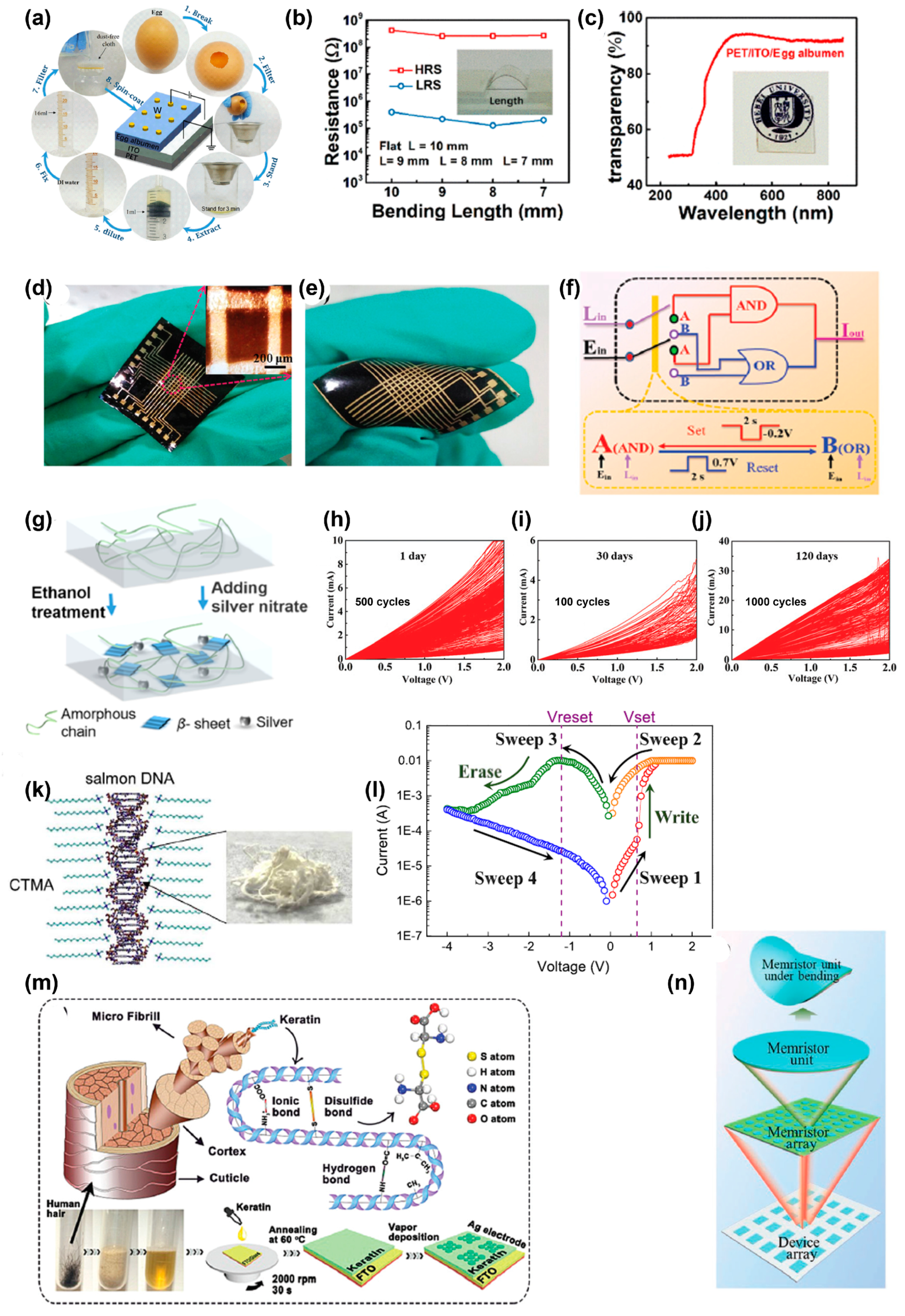
6. Summary and Outlook
Author Contributions
Funding
Data Availability Statement
Conflicts of Interest
References
- Philip Chen, C.L.; Zhang, C.-Y. Data-intensive applications, challenges, techniques and technologies: A survey on Big Data. Inform. Sci. 2014, 275, 314–347. [Google Scholar] [CrossRef]
- Service, R.F. Chipmakers look past Moore's law, and silicon. Science 2018, 361, 321. [Google Scholar] [CrossRef] [PubMed]
- Lundstrom, M. Moore's Law Forever? Science 2003, 299, 210–211. [Google Scholar] [CrossRef] [PubMed]
- Kolar, J.; Macak, J.M.; Terabe, K.; Wagner, T. Down-scaling of resistive switching to nanoscale using porous anodic alumina membranes. J. Mater. Chem. C 2014, 2, 349–355. [Google Scholar] [CrossRef]
- Zahoor, F.; Azni Zulkifli, T.Z.; Khanday, F.A. Resistive Random Access Memory (RRAM): An Overview of Materials, Switching Mechanism, Performance, Multilevel Cell (mlc) Storage, Modeling, and Applications. Nanoscale Res. Lett. 2020, 15, 90. [Google Scholar] [CrossRef]
- Zhang, Z.; Wang, Z.; Shi, T.; Bi, C.; Rao, F.; Cai, Y.; Liu, Q.; Wu, H.; Zhou, P. Memory materials and devices: From concept to application. InfoMat 2020, 2, 261–290. [Google Scholar] [CrossRef]
- Salinga, M.; Kersting, B.; Ronneberger, I.; Jonnalagadda, V.P.; Vu, X.T.; Le Gallo, M.; Giannopoulos, I.; Cojocaru-Mirédin, O.; Mazzarello, R.; Sebastian, A. Monatomic phase change memory. Nat. Mater. 2018, 17, 681–685. [Google Scholar] [CrossRef]
- Ciocchini, N.; Laudato, M.; Boniardi, M.; Varesi, E.; Fantini, P.; Lacaita, A.L.; Ielmini, D. Bipolar switching in chalcogenide phase change memory. Sci. Rep. 2016, 6, 29162. [Google Scholar] [CrossRef]
- Zhu, J.G.; Shadman, A. Resonant Spin-Transfer Torque Magnetoresistive Memory. IEEE Trans. Magn. 2019, 55, 3400407. [Google Scholar] [CrossRef]
- Khang, N.H.D.; Ueda, Y.; Hai, P.N. A conductive topological insulator with large spin Hall effect for ultralow power spin–orbit torque switching. Nat. Mater. 2018, 17, 808–813. [Google Scholar] [CrossRef]
- Ando, K.; Fujita, S.; Ito, J.; Yuasa, S.; Suzuki, Y.; Nakatani, Y.; Miyazaki, T.; Yoda, H. Spin-transfer torque magnetoresistive random-access memory technologies for normally off computing. J. Appl. Phys. 2014, 115, 172607. [Google Scholar] [CrossRef]
- Lastras-Montaño, M.A.; Cheng, K.-T. Resistive random-access memory based on ratioed memristors. Nat. Electron. 2018, 1, 466–472. [Google Scholar] [CrossRef]
- Wan, W.; Kubendran, R.; Schaefer, C.; Eryilmaz, S.B.; Zhang, W.; Wu, D.; Deiss, S.; Raina, P.; Qian, H.; Gao, B.; et al. A compute-in-memory chip based on resistive random-access memory. Nature 2022, 608, 504–512. [Google Scholar] [CrossRef] [PubMed]
- Rao, K.D.M.; Sagade, A.A.; John, R.; Pradeep, T.; Kulkarni, G.U. Defining Switching Efficiency of Multilevel Resistive Memory with PdO as an Example. Adv. Electron. Mater. 2016, 2, 1500286. [Google Scholar] [CrossRef]
- Li, H.; Xu, Q.; Li, N.; Sun, R.; Ge, J.; Lu, J.; Gu, H.; Yan, F. A Small-Molecule-Based Ternary Data-Storage Device. J. Am. Chem. Soc. 2010, 132, 5542–5543. [Google Scholar] [CrossRef] [PubMed]
- Gu, P.-Y.; Gao, J.; Lu, C.-J.; Chen, W.; Wang, C.; Li, G.; Zhou, F.; Xu, Q.-F.; Lu, J.-M.; Zhang, Q. Synthesis of tetranitro-oxacalix[4]arene with oligoheteroacene groups and its nonvolatile ternary memory performance. Mater. Horiz. 2014, 1, 446–451. [Google Scholar] [CrossRef]
- Lin, W.-P.; Liu, S.-J.; Gong, T.; Zhao, Q.; Huang, W. Polymer-Based Resistive Memory Materials and Devices. Adv. Mater. 2014, 26, 570–606. [Google Scholar] [CrossRef]
- Han, S.-T.; Zhou, Y.; Roy, V.A.L. Towards the Development of Flexible Non-Volatile Memories. Adv. Mater. 2013, 25, 5425–5449. [Google Scholar] [CrossRef]
- Sun, G.; Liu, J.; Zheng, L.; Huang, W.; Zhang, H. Preparation of Weavable, All-Carbon Fibers for Non-Volatile Memory Devices. Angew. Chem. Int. Ed. 2013, 52, 13351–13355. [Google Scholar] [CrossRef]
- Lee, J.H.; Park, S.P.; Park, K.; Kim, H.J. Flexible and Waterproof Resistive Random-Access Memory Based on Nitrocellulose for Skin-Attachable Wearable Devices. Adv. Funct. Mater. 2020, 30, 1907437. [Google Scholar] [CrossRef]
- Li, Y.; Qian, Q.; Zhu, X.; Li, Y.; Zhang, M.; Li, J.; Ma, C.; Li, H.; Lu, J.; Zhang, Q. Recent advances in organic-based materials for resistive memory applications. InfoMat 2020, 2, 995–1033. [Google Scholar] [CrossRef]
- Gao, S.; Yi, X.; Shang, J.; Liu, G.; Li, R.W. Organic and hybrid resistive switching materials and devices. Chem. Soc. Rev. 2018, 48, 1531–1565. [Google Scholar] [CrossRef] [PubMed]
- Song, S.; Cho, B.; Kim, T.-W.; Ji, Y.; Jo, M.; Wang, G.; Choe, M.; Kahng, Y.H.; Hwang, H.; Lee, T. Three-Dimensional Integration of Organic Resistive Memory Devices. Adv. Mater. 2010, 22, 5048–5052. [Google Scholar] [CrossRef] [PubMed]
- Han, J.; Lian, H.; Cheng, X.; Dong, Q.; Qu, Y.; Wong, W.-Y. Study of Electronic and Steric Effects of Different Substituents in Donor–Acceptor Molecules on Multilevel Organic Memory Data Storage Performance. Adv. Electron. Mater. 2021, 7, 2001097. [Google Scholar] [CrossRef]
- Zhang, G.; Lee, Y.-J.; Gautam, P.; Lin, C.-C.; Liu, C.-L.; Chan, J.M.W. Pentafluorosulfanylated polymers as electrets in nonvolatile organic field-effect transistor memory devices. J. Mater. Chem. C 2019, 7, 7865–7871. [Google Scholar] [CrossRef]
- Liu, H.; Wang, C.; Han, G.; Li, J.; Peng, Y.; Liu, Y.; Wang, X.; Zhong, N.; Duan, C.; Wang, X.; et al. ZrO2 Ferroelectric FET for Non-volatile Memory Application. IEEE Electr. Device Lett. 2019, 40, 1419–1422. [Google Scholar] [CrossRef]
- Zhou, L.; Mao, J.; Ren, Y.; Han, S.-T.; Roy, V.A.L.; Zhou, Y. Recent Advances of Flexible Data Storage Devices Based on Organic Nanoscaled Materials. Small 2018, 14, 1703126. [Google Scholar] [CrossRef]
- Xu, T.; Guo, S.; Qi, W.; Li, S.; Xu, M.; Xie, W.; Wang, W. High-performance flexible organic thin-film transistor nonvolatile memory based on molecular floating-gate and pn-heterojunction channel layer. Appl. Phys. Lett. 2020, 116, 023301. [Google Scholar] [CrossRef]
- Higashinakaya, M.; Nagase, T.; Abe, H.; Hattori, R.; Tazuhara, S.; Kobayashi, T.; Naito, H. Electrically programmable multilevel nonvolatile memories based on solution-processed organic floating-gate transistors. Appl. Phys. Lett. 2021, 118, 103301. [Google Scholar] [CrossRef]
- Wang, H.; Wen, Y.; Zeng, H.; Xiong, Z.; Tu, Y.; Zhu, H.; Cheng, R.; Yin, L.; Jiang, J.; Zhai, B.; et al. Two-Dimensional Ferroic Materials for Non-volatile Memory Applications. Adv. Mater. 2023, 2305044. [Google Scholar] [CrossRef]
- Hong, Z.; Zhao, J.; Huang, K.; Cheng, B.; Xiao, Y.; Lei, S. Controllable switching properties in an individual CH3NH3PbI3 micro/nanowire-based transistor for gate voltage and illumination dual-driving non-volatile memory. J. Mater. Chem. C 2019, 7, 4259–4266. [Google Scholar] [CrossRef]
- Ling, Q.-D.; Song, Y.; Lim, S.-L.; Teo, E.Y.-H.; Tan, Y.-P.; Zhu, C.; Chan, D.S.H.; Kwong, D.-L.; Kang, E.-T.; Neoh, K.-G. A Dynamic Random Access Memory Based on a Conjugated Copolymer Containing Electron-Donor and -Acceptor Moieties. Angew. Chem. Int. Ed. 2006, 45, 2947–2951. [Google Scholar] [CrossRef] [PubMed]
- Zhu, M.-G.; Zhang, Z.; Peng, L.-M. High-Performance and Radiation-Hard Carbon Nanotube Complementary Static Random-Access Memory. Adv. Electron. Mater. 2019, 5, 1900313. [Google Scholar] [CrossRef]
- Avila-Niño, J.A.; Patchett, E.R.; Taylor, D.M.; Assender, H.E.; Yeates, S.G.; Ding, Z.; Morrison, J.J. Stable organic static random access memory from a roll-to-roll compatible vacuum evaporation process. Org. Electron. 2016, 31, 77–81. [Google Scholar] [CrossRef]
- Spessot, A.; Oh, H. 1T-1C Dynamic Random Access Memory Status, Challenges, and Prospects. IEEE Trans. Electron. Dev. 2020, 67, 1382–1393. [Google Scholar] [CrossRef]
- Saha, M.; Dey, S.; Nawaz, S.M.; Mallik, A. Environment-friendly resistive memory based on natural casein: Role of electrode and bio-material concentration. Org. Electron. 2023, 121, 106869. [Google Scholar] [CrossRef]
- Hsieh, H.-C.; Wu, N.; Chuang, T.-H.; Lee, W.-Y.; Chen, J.-Y.; Chen, W.-C. Eco-Friendly Polyfluorene/Poly(butylene succinate) Blends and Their Electronic Device Application on Biodegradable Substrates. ACS Appl. Polym. Mater. 2020, 2, 2469–2476. [Google Scholar] [CrossRef]
- Kumar, D.; Aluguri, R.; Chand, U.; Tseng, T.Y. Metal oxide resistive switching memory: Materials, properties and switching mechanisms. Ceram. Int. 2017, 43, S547–S556. [Google Scholar] [CrossRef]
- Ling, Q.-D.; Lim, S.-L.; Song, Y.; Zhu, C.-X.; Chan, D.S.-H.; Kang, E.-T.; Neoh, K.-G. Nonvolatile Polymer Memory Device Based on Bistable Electrical Switching in a Thin Film of Poly(N-vinylcarbazole) with Covalently Bonded C60. Langmuir 2007, 23, 312–319. [Google Scholar] [CrossRef]
- Xie, L.-H.; Ling, Q.-D.; Hou, X.-Y.; Huang, W. An Effective Friedel−Crafts Postfunctionalization of Poly(N-vinylcarbazole) to Tune Carrier Transportation of Supramolecular Organic Semiconductors Based on π-Stacked Polymers for Nonvolatile Flash Memory Cell. J. Am. Chem. Soc. 2008, 130, 2120–2121. [Google Scholar] [CrossRef]
- Zhou, Z.; Mao, H.; Wang, X.; Sun, T.; Chang, Q.; Chen, Y.; Xiu, F.; Liu, Z.; Liu, J.; Huang, W. Transient and flexible polymer memristors utilizing full-solution processed polymer nanocomposites. Nanoscale 2018, 10, 14824–14829. [Google Scholar] [CrossRef] [PubMed]
- Kadhim, M.S.; Yang, F.; Sun, B.; Wang, Y.; Guo, T.; Jia, Y.; Yuan, L.; Yu, Y.; Zhao, Y. A resistive switching memory device with a negative differential resistance at room temperature. Appl. Phys. Lett. 2018, 113, 053502. [Google Scholar] [CrossRef]
- Li, Y.; Zhu, X.; Li, Y.; Zhang, M.; Ma, C.; Li, H.; Lu, J.; Zhang, Q. Highly Robust Organometallic Small-Molecule-Based Nonvolatile Resistive Memory Controlled by a Redox-Gated Switching Mechanism. ACS Appl. Mater. Interfaces 2019, 11, 40332–40338. [Google Scholar] [CrossRef] [PubMed]
- Li, Y.-Q.; Fang, R.-C.; Zheng, A.-M.; Chu, Y.-Y.; Tao, X.; Xu, H.-H.; Ding, S.-J.; Shen, Y.-Z. Nonvolatile memory devices based on polyimides bearing noncoplanar twisted biphenyl units containing carbazole and triphenylamine side-chain groups. J Mater. Chem. 2011, 21, 15643–15654. [Google Scholar] [CrossRef]
- Ling, Q.-D.; Chang, F.-C.; Song, Y.; Zhu, C.-X.; Liaw, D.-J.; Chan, D.S.-H.; Kang, E.-T.; Neoh, K.-G. Synthesis and Dynamic Random Access Memory Behavior of a Functional Polyimide. J. Am. Chem. Soc. 2006, 128, 8732–8733. [Google Scholar] [CrossRef]
- Zhang, B.; Liu, Y.-L.; Chen, Y.; Neoh, K.-G.; Li, Y.-X.; Zhu, C.-X.; Tok, E.-S.; Kang, E.-T. Nonvolatile Rewritable Memory Effects in Graphene Oxide Functionalized by Conjugated Polymer Containing Fluorene and Carbazole Units. Chem. Eur. J. 2011, 17, 10304–10311. [Google Scholar] [CrossRef]
- Liu, S.-J.; Wang, P.; Zhao, Q.; Yang, H.-Y.; Wong, J.; Sun, H.-B.; Dong, X.-C.; Lin, W.-P.; Huang, W. Single Polymer-Based Ternary Electronic Memory Material and Device. Adv. Mater. 2012, 24, 2901–2905. [Google Scholar] [CrossRef]
- Bozano, L.D.; Kean, B.W.; Beinhoff, M.; Carter, K.R.; Rice, P.M.; Scott, J.C. Organic Materials and Thin-Film Structures for Cross-Point Memory Cells Based on Trapping in Metallic Nanoparticles. Adv. Funct. Mater. 2005, 15, 1933–1939. [Google Scholar] [CrossRef]
- Zhang, P.; Xu, B.; Gao, C.; Chen, G.; Gao, M. Facile Synthesis of Co9Se8 Quantum Dots as Charge Traps for Flexible Organic Resistive Switching Memory Device. ACS Appl. Mater. Interfaces 2016, 8, 30336–30343. [Google Scholar] [CrossRef]
- Ouyang, J.; Chu, C.-W.; Szmanda, C.R.; Ma, L.; Yang, Y. Programmable polymer thin film and non-volatile memory device. Nat. Mater. 2004, 3, 918–922. [Google Scholar] [CrossRef]
- Qi, S.; Iida, H.; Liu, L.; Irle, S.; Hu, W.; Yashima, E. Electrical Switching Behavior of a [60]Fullerene-Based Molecular Wire Encapsulated in a Syndiotactic Poly(methyl methacrylate) Helical Cavity. Angew. Chem. Int. Ed. 2013, 52, 1049–1053. [Google Scholar] [CrossRef] [PubMed]
- Sun, Y.; Li, L.; Wen, D.; Bai, X. Bistable electrical switching and nonvolatile memory effect in mixed composite of oxadiazole acceptor and carbazole donor. Org. Electron. 2015, 25, 283–288. [Google Scholar] [CrossRef]
- Cho, B.; Yun, J.-M.; Song, S.; Ji, Y.; Kim, D.-Y.; Lee, T. Direct Observation of Ag Filamentary Paths in Organic Resistive Memory Devices. Adv. Funct. Mater. 2011, 21, 3976–3981. [Google Scholar] [CrossRef]
- Gao, S.; Song, C.; Chen, C.; Zeng, F.; Pan, F. Formation process of conducting filament in planar organic resistive memory. Appl. Phys. Lett. 2013, 102, 141606. [Google Scholar] [CrossRef]
- Chen, X.; Huang, P.; Zhu, X.; Zhuang, S.; Zhu, H.; Fu, J.; Nissimagoudar, A.S.; Li, W.; Zhang, X.; Zhou, L.; et al. Keggin-type polyoxometalate cluster as an active component for redox-based nonvolatile memory. Nanoscale Horiz. 2019, 4, 697–704. [Google Scholar] [CrossRef]
- Shan, Y.; Lyu, Z.; Guan, X.; Younis, A.; Yuan, G.; Wang, J.; Li, S.; Wu, T. Solution-processed resistive switching memory devices based on hybrid organic-inorganic materials and composites. Phys. Chem. Chem. Phys. 2018, 20, 23837–23846. [Google Scholar] [CrossRef]
- Choi, T.-L.; Lee, K.-H.; Joo, W.-J.; Lee, S.; Lee, T.-W.; Chae, M.Y. Synthesis and Nonvolatile Memory Behavior of Redox-Active Conjugated Polymer-Containing Ferrocene. J. Am. Chem. Soc. 2007, 129, 9842–9843. [Google Scholar] [CrossRef]
- Liu, G.; Wang, C.; Zhang, W.; Pan, L.; Zhang, C.; Yang, X.; Fan, F.; Chen, Y.; Li, R.-W. Organic Biomimicking Memristor for Information Storage and Processing Applications. Adv. Electron. Mater. 2016, 2, 1500298. [Google Scholar] [CrossRef]
- Pan, L.; Hu, B.; Zhu, X.; Chen, X.; Shang, J.; Tan, H.; Xue, W.; Zhu, Y.; Liu, G.; Li, R.-W. Role of oxadiazole moiety in different D–A polyazothines and related resistive switching properties. J. Mater. Chem. C 2013, 1, 4556–4564. [Google Scholar] [CrossRef]
- Zhang, H.; Zhou, Y.; Wang, C.; Wang, S. Realizing the Conversion of Resistive Switching Behavior from Binary to Ternary by Adjusting the Charge Traps in the Polymers. ACS Appl. Electron. Mater. 2021, 3, 2807–2817. [Google Scholar] [CrossRef]
- Zhang, B.; Fan, F.; Xue, W.; Liu, G.; Fu, Y.; Zhuang, X.; Xu, X.-H.; Gu, J.; Li, R.-W.; Chen, Y. Redox gated polymer memristive processing memory unit. Nat. Commun. 2019, 10, 736. [Google Scholar] [CrossRef] [PubMed]
- Jung, Y.; Li, W.; Kim, J.; Michinobu, T.; Ree, M. n-Type Digital Memory Characteristics of Diketopyrrolopyrrole-Based Narrow Bandgap Polymers. J. Phys. Chem. C 2021, 125, 27479–27488. [Google Scholar] [CrossRef]
- Cheng, X.; Md, A.; Lian, H.; Zhong, Z.; Guo, H.; Dong, Q.; Roy, V.A.L. Study on synthesis, characterization, and nonvolatile memory behavior of ferrocene-containing metallopolymers. J. Organomet. Chem. 2019, 892, 34–40. [Google Scholar] [CrossRef]
- Ren, Y.; Lin, W.-C.; Ting, L.-Y.; Ding, G.; Yang, B.; Yang, J.-Q.; Chou, H.-H.; Han, S.-T.; Zhou, Y. Iridium-based polymer for memristive devices with integrated logic and arithmetic applications. J. Mater. Chem. C 2020, 8, 16845–16857. [Google Scholar] [CrossRef]
- Barman, B.K.; Ghosh, N.G.; Giri, I.; Kumar, C.; Zade, S.S.; Vijayaraghavan, R.K. Incorporating a redox active entity to attain electrical bistability in a polymer semiconductor. Nanoscale 2021, 13, 6759–6763. [Google Scholar] [CrossRef]
- Ree, B.J.; Isono, T.; Satoh, T. Chemically Controlled Volatile and Nonvolatile Resistive Memory Characteristics of Novel Oxygen-Based Polymers. ACS Appl. Mater. Interfaces 2020, 12, 28435–28445. [Google Scholar] [CrossRef]
- Ryu, W.; Xiang, L.; Jin, K.S.; Kim, H.-J.; Kim, H.-C.; Ree, M. Newly Found Digital Memory Characteristics of Pyrrolidone- and Succinimide-Based Polymers. Macromol. Rapid Comm. 2021, 42, 2100186. [Google Scholar] [CrossRef]
- Yang, B.; Tao, P.; Ma, C.; Tang, R.; Gong, T.; Liu, S.; Zhao, Q. Iridium(iii) complex-containing non-conjugated polymers for non-volatile memory induced by switchable through-space charge transfer. J. Mater. Chem. C 2020, 8, 5449–5455. [Google Scholar] [CrossRef]
- Hu, B.; Wang, C.; Wang, J.; Gao, J.; Wang, K.; Wu, J.; Zhang, G.; Cheng, W.; Venkateswarlu, B.; Wang, M.; et al. Inorganic–organic hybrid polymer with multiple redox for high-density data storage. Chem. Sci. 2014, 5, 3404–3408. [Google Scholar] [CrossRef]
- Liu, G.; Ling, Q.-D.; Teo, E.Y.H.; Zhu, C.-X.; Chan, D.S.-H.; Neoh, K.-G.; Kang, E.-T. Electrical Conductance Tuning and Bistable Switching in Poly(N-vinylcarbazole)−Carbon Nanotube Composite Films. ACS Nano 2009, 3, 1929–1937. [Google Scholar] [CrossRef]
- Pan, S.; Zhu, Z.; Yu, H.; Lan, W.; Wei, B.; Guo, K. Switching the resistive memory behavior from binary to ternary logic via subtle polymer donor and molecular acceptor design. J. Mater. Chem. C 2021, 9, 5643–5651. [Google Scholar] [CrossRef]
- Li, W.; Zhu, H.; Sun, T.; Qu, W.; Fan, X.; Gao, Z.; Shi, W.; Wei, B. High On/Off Ratio Organic Resistive Switching Memory Based on Carbazolyl Dicyanobenzene and a Polymer Composite. J. Phys. Chem. C 2022, 126, 12897–12905. [Google Scholar] [CrossRef]
- Sun, Y.; Wen, D. Nonvolatile WORM and rewritable multifunctional resistive switching memory devices from poly(4-vinyl phenol) and 2-amino-5-methyl-1,3,4-thiadiazole composite. J. Alloys Compd. 2019, 806, 215–226. [Google Scholar] [CrossRef]
- Li, M.; An, H.; Kim, T.W. Highly flexible and stable memristive devices based on hexagonal boron-nitride nanosheets: Polymethyl methacrylate nanocomposites. Org. Electron. 2021, 99, 106322. [Google Scholar] [CrossRef]
- Zhou, Y.; Zhao, X.; Chen, J.; Gao, M.; He, Z.; Wang, S.; Wang, C. Ternary Flash Memory with a Carbazole-Based Conjugated Copolymer: WS2 Composites as Active Layers. Langmuir 2022, 38, 3113–3121. [Google Scholar] [CrossRef]
- Lin, Y.; Zhang, X.; Shan, X.; Zeng, T.; Zhao, X.; Wang, Z.; Kang, Z.; Xu, H.; Liu, Y. Photo-tunable organic resistive random access memory based on PVP/N-doped carbon dot nanocomposites for encrypted image storage. J. Mater. Chem. C 2020, 8, 14789–14795. [Google Scholar] [CrossRef]
- An, H.; Kim, Y.; Li, M.; Kim, T.W. Highly Self-Healable Write-Once-Read-Many-Times Devices Based on Polyvinylalcohol-Imidazole Modified Graphene Nanocomposites. Small 2021, 17, 2102772. [Google Scholar] [CrossRef]
- An, H.; Ge, Y.; Li, M.; Kim, T.W. Storage Mechanisms of Polyimide-Molybdenum Disulfide Quantum Dot Based, Highly Stable, Write-Once-Read-Many-Times Memristive Devices. Adv. Electron. Mater. 2021, 7, 2000593. [Google Scholar] [CrossRef]
- Jiang, T.; Meng, X.; Zhou, Z.; Wu, Y.; Tian, Z.; Liu, Z.; Lu, G.; Eginlidil, M.; Yu, H.-D.; Liu, J.; et al. Highly flexible and degradable memory electronics comprised of all-biocompatible materials. Nanoscale 2021, 13, 724–729. [Google Scholar] [CrossRef]
- Pradhan, R.R.; Bera, J.; Betal, A.; Dagar, P.; Sahu, S. Hot Injection-Based Synthesized Colloidal CdSe Quantum Dots Embedded in Poly(4-vinylpyridine) (PVP) Matrix Form a Nanoscale Heterostructure for a High On–Off Ratio Memory-Switching Device. ACS Appl. Mater. Interfaces 2021, 13, 25064–25071. [Google Scholar] [CrossRef]
- Jeon, N.J.; Noh, J.H.; Yang, W.S.; Kim, Y.C.; Ryu, S.; Seo, J.; Seok, S.I. Compositional engineering of perovskite materials for high-performance solar cells. Nature 2015, 517, 476. [Google Scholar] [CrossRef] [PubMed]
- Liu, M.; Johnston, M.B.; Snaith, H.J. Efficient planar heterojunction perovskite solar cells by vapour deposition. Nature 2013, 501, 395–398. [Google Scholar] [CrossRef]
- Tsai, H.; Nie, W.; Blancon, J.C.; Stoumpos, C.C.; Asadpour, R.; Harutyunyan, B.; Neukirch, A.J.; Verduzco, R.; Crochet, J.J.; Tretiak, S.; et al. High-efficiency two-dimensional Ruddlesden-Popper perovskite solar cells. Nature 2016, 536, 312–316. [Google Scholar] [CrossRef] [PubMed]
- Yoo, E.J.; Lyu, M.; Yun, J.H.; Kang, C.J.; Choi, Y.J.; Wang, L. Resistive Switching Behavior in Organic-Inorganic Hybrid CH3 NH3 PbI3-x Clx Perovskite for Resistive Random Access Memory Devices. Adv. Mater. 2015, 27, 6170–6175. [Google Scholar] [CrossRef]
- Guan, X.; Lei, Z.; Yu, X.; Lin, C.-H.; Huang, J.-K.; Huang, C.-Y.; Hu, L.; Li, F.; Vinu, A.; Yi, J.; et al. Low-Dimensional Metal-Halide Perovskites as High-Performance Materials for Memory Applications. Small 2022, 18, 2203311. [Google Scholar] [CrossRef]
- Liu, Q.; Gao, S.; Xu, L.; Yue, W.J.; Zhang, C.W.; Kan, H.; Li, Y.; Shen, G.Z. Nanostructured perovskites for nonvolatile memory devices. Chem. Soc. Rev. 2022, 51, 3341–3379. [Google Scholar] [CrossRef] [PubMed]
- Wang, C.; Chen, Y.; Zhang, B.; Liu, S.; Chen, Q.; Cao, Y.; Sun, S. High-efficiency bulk heterojunction memory devices fabricated using organometallic halide perovskite: Poly(N-vinylcarbazole) blend active layers. Dalton Trans. 2016, 45, 484–488. [Google Scholar] [CrossRef]
- Zhang, D.; Zhu, S.; Zeng, J.; Ma, H.; Gao, J.; Yao, R.; He, Z. Significance of polymer matrix on the resistive switching performance of lead-free double perovskite nanocomposite based flexible memory device. Ceram. Int. 2023, 49, 25105–25112. [Google Scholar] [CrossRef]
- Jiang, Q.; Ren, Y.; Cui, Z.; Li, Z.; Hu, L.; Guo, R.; Duan, S.; Xie, F.; Zhou, G.; Xiong, S. CsPbBr3 Perovskite Quantum Dots Embedded in Polystyrene-poly2-vinyl Pyridine Copolymer for Robust and Light-Tunable Memristors. ACS Appl. Nano Mater. 2023, 6, 8655–8667. [Google Scholar] [CrossRef]
- Zhuang, X.; Mai, Y.; Wu, D.; Zhang, F.; Feng, X. Two-Dimensional Soft Nanomaterials: A Fascinating World of Materials. Adv. Mater. 2015, 27, 403–427. [Google Scholar] [CrossRef]
- Murray, D.J.; Patterson, D.D.; Payamyar, P.; Bhola, R.; Song, W.; Lackinger, M.; Schlüter, A.D.; King, B.T. Large Area Synthesis of a Nanoporous Two-Dimensional Polymer at the Air/Water Interface. J. Am. Chem. Soc. 2015, 137, 3450–3453. [Google Scholar] [CrossRef]
- Muñoz, R.; Gómez-Aleixandre, C. Review of CVD Synthesis of Graphene. Chem. Vap. Depos. 2013, 19, 297–322. [Google Scholar] [CrossRef]
- Liu, C.; Park, E.; Jin, Y.; Liu, J.; Yu, Y.; Zhang, W.; Lei, S.; Hu, W. Separation of Arylenevinylene Macrocycles with a Surface-Confined Two-Dimensional Covalent Organic Framework. Angew. Chem. Int. Ed. 2018, 57, 8984–8988. [Google Scholar] [CrossRef] [PubMed]
- Zhou, P.-K.; Yu, H.; Li, Y.; Yu, H.; Chen, Q.; Chen, X. Recent advances in covalent organic polymers-based thin films as memory devices. J Polym. Sci. 2023, 1–18. [Google Scholar] [CrossRef]
- Liu, J.; Yang, F.; Cao, L.; Li, B.; Yuan, K.; Lei, S.; Hu, W. A Robust Nonvolatile Resistive Memory Device Based on a Freestanding Ultrathin 2D Imine Polymer Film. Adv. Mater. 2019, 31, 1902264. [Google Scholar] [CrossRef]
- Song, Y.; Liu, J.; Li, W.; Liu, L.; Yang, L.; Lei, S.; Hu, W. Effect of functional groups on microporous polymer based resistance switching memory devices. Chem. Commun. 2020, 56, 6356–6359. [Google Scholar] [CrossRef]
- Song, Y.; Feng, G.; Sun, C.; Liang, Q.; Wu, L.; Yu, X.; Lei, S.; Hu, W. Ternary Conductance Switching Realized by a Pillar[5]arene-Functionalized Two-Dimensional Imine Polymer Film. Chem. Eur. J. 2021, 27, 13605–13612. [Google Scholar] [CrossRef]
- Song, Y.; Feng, G.; Wu, L.; Zhang, E.; Sun, C.; Fa, D.; Liang, Q.; Lei, S.; Yu, X.; Hu, W. A two-dimensional polymer memristor based on conformational changes with tunable resistive switching behaviours. J. Mater. Chem. C 2022, 10, 2631–2638. [Google Scholar] [CrossRef]
- Sun, B.; Li, X.; Feng, T.; Cai, S.; Chen, T.; Zhu, C.; Zhang, J.; Wang, D.; Liu, Y. Resistive Switching Memory Performance of Two-Dimensional Polyimide Covalent Organic Framework Films. ACS Appl. Mater. Interfaces 2020, 12, 51837–51845. [Google Scholar] [CrossRef]
- Liu, L.; Geng, B.; Ji, W.; Wu, L.; Lei, S.; Hu, W. A Highly Crystalline Single Layer 2D Polymer for Low Variability and Excellent Scalability Molecular Memristors. Adv. Mater. 2023, 35, 2208377. [Google Scholar] [CrossRef]
- Li, C.; Li, D.; Zhang, W.; Li, H.; Yu, G. Towards High-Performance Resistive Switching Behavior through Embedding a D-A System into 2D Imine-Linked Covalent Organic Frameworks. Angew. Chem. Int. Ed. 2021, 60, 27135–27143. [Google Scholar] [CrossRef] [PubMed]
- Wu, D.; Che, Q.; He, H.; El-Khouly, M.E.; Huang, S.; Zhuang, X.; Zhang, B.; Chen, Y. Room-Temperature Interfacial Synthesis of Vinylene-Bridged Two-Dimensional Covalent Organic Framework Thin Film for Nonvolatile Memory. ACS Mater. Lett. 2023, 5, 874–883. [Google Scholar] [CrossRef]
- Zhao, Z.; El-Khouly, M.E.; Che, Q.; Sun, F.; Zhang, B.; He, H.; Chen, Y. Redox-Active Azulene-based 2D Conjugated Covalent Organic Framework for Organic Memristors. Angew. Chem. Int. Ed. 2023, 62, e202217249. [Google Scholar] [CrossRef] [PubMed]
- Zhang, B.; Chen, W.; Zeng, J.; Fan, F.; Gu, J.; Chen, X.; Yan, L.; Xie, G.; Liu, S.; Yan, Q.; et al. 90% yield production of polymer nano-memristor for in-memory computing. Nat. Commun. 2021, 12, 1984. [Google Scholar] [CrossRef] [PubMed]
- Rehman, M.M.; Ur Rehman, H.M.M.; Kim, W.Y.; Sherazi, S.S.H.; Rao, M.W.; Khan, M.; Muhammad, Z. Biomaterial-Based Nonvolatile Resistive Memory Devices toward Ecofriendliness and Biocompatibility. ACS Appl. Electron. Mater. 2021, 3, 2832–2861. [Google Scholar] [CrossRef]
- Zhang, Y.; Fan, S.; Zhang, Y. Bio-memristors based on silk fibroin. Mater. Horiz. 2021, 8, 3281–3294. [Google Scholar] [CrossRef]
- Yan, X.; Li, X.; Zhou, Z.; Zhao, J.; Wang, H.; Wang, J.; Zhang, L.; Ren, D.; Zhang, X.; Chen, J.; et al. Flexible Transparent Organic Artificial Synapse Based on the Tungsten/Egg Albumen/Indium Tin Oxide/Polyethylene Terephthalate Memristor. ACS Appl. Mater. Interfaces 2019, 11, 18654–18661. [Google Scholar] [CrossRef]
- Zhou, G.; Ren, Z.; Wang, L.; Sun, B.; Duan, S.; Song, Q. Artificial and wearable albumen protein memristor arrays with integrated memory logic gate functionality. Mater. Horiz. 2019, 6, 1877–1882. [Google Scholar] [CrossRef]
- Wang, L.; Zhu, H.; Zuo, Z.; Wen, D. Full-function logic circuit based on egg albumen resistive memory. Appl. Phys. Lett. 2022, 121, 243505. [Google Scholar] [CrossRef]
- Wang, L.; Yang, T.; Wen, D. Tunable Multilevel Data Storage Bioresistive Random Access Memory Device Based on Egg Albumen and Carbon Nanotubes. Nanomaterials 2021, 11, 2085. [Google Scholar] [CrossRef]
- Zhang, Y.; Han, F.; Fan, S.; Zhang, Y. Low-Power and Tunable-Performance Biomemristor Based on Silk Fibroin. ACS Biomater. Sci. Eng. 2021, 7, 3459–3468. [Google Scholar] [CrossRef] [PubMed]
- Wang, W.; Zhou, G.; Wang, Y.; Sun, B.; Zhou, M.; Fang, C.; Xu, C.; Dong, J.; Wang, F.; Duan, S.; et al. An analogue memristor made of silk fibroin polymer. J. Mater. Chem. C 2021, 9, 14583–14588. [Google Scholar] [CrossRef]
- Liu, S.; Cheng, Y.; Han, F.; Fan, S.; Zhang, Y. Multilevel resistive switching memristor based on silk fibroin/graphene oxide with image reconstruction functionality. Chem. Eng. J. 2023, 471, 144678. [Google Scholar] [CrossRef]
- Jeng, H.-Y.; Yang, T.-C.; Yang, L.; Grote, J.G.; Chen, H.-L.; Hung, Y.-C. Non-volatile resistive memory devices based on solution-processed natural DNA biomaterial. Org. Electron. 2018, 54, 216–221. [Google Scholar] [CrossRef]
- Lin, Q.; Hao, S.; Hu, W.; Wang, M.; Zang, Z.; Zhu, L.; Du, J.; Tang, X. Human hair keratin for physically transient resistive switching memory devices. J. Mater. Chem. C 2019, 7, 3315–3321. [Google Scholar] [CrossRef]
- Sun, B.; Chen, Y.; Zhou, G.; Zhou, Y.; Guo, T.; Zhu, S.; Mao, S.; Zhao, Y.; Shao, J.; Li, Y. A Flexible Corn Starch-Based Biomaterial Device Integrated with Capacitive-Coupled Memristive Memory, Mechanical Stress Sensing, Synapse, and Logic Operation Functions. Adv. Electron. Mater. 2023, 9, 2201017. [Google Scholar] [CrossRef]
- Hung, Y.-C.; Hsu, W.-T.; Lin, T.-Y.; Fruk, L. Photoinduced write-once read-many-times memory device based on DNA biopolymer nanocomposite. Appl. Phys. Lett. 2011, 99, 253301. [Google Scholar] [CrossRef]
- Abbas, Y.; Dugasani, S.R.; Raza, M.T.; Jeon, Y.-R.; Park, S.H.; Choi, C. The observation of resistive switching characteristics using transparent and biocompatible Cu2+-doped salmon DNA composite thin film. Nanotechnology 2019, 30, 335203. [Google Scholar] [CrossRef]
- Xia, J.; Zhang, Z.; He, H.; Xu, Y.; Dong, D.; Yang, R.; Miao, X. Environment-friendly regenerated cellulose based flexible memristive device. Appl. Phys. Lett. 2021, 119, 201904. [Google Scholar] [CrossRef]

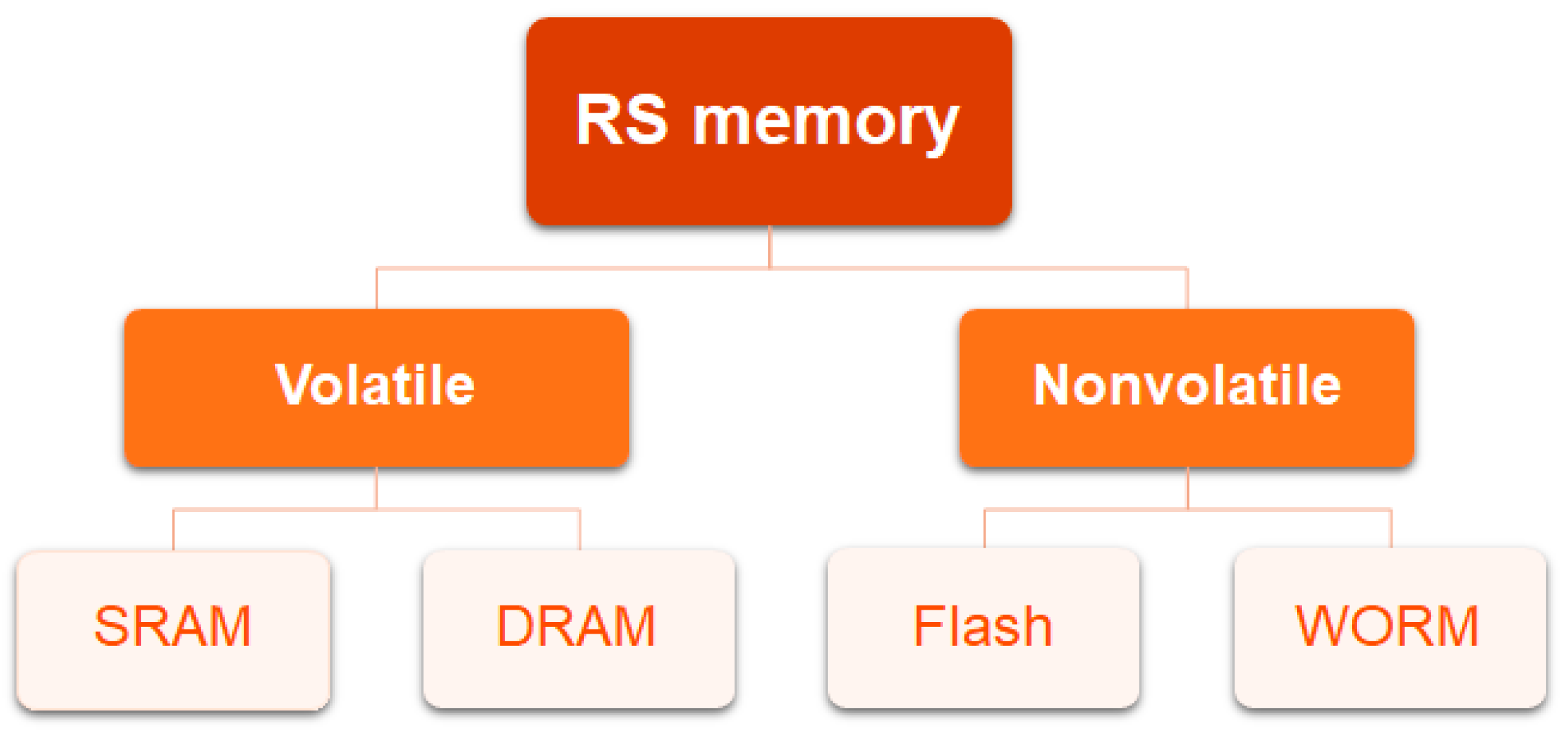
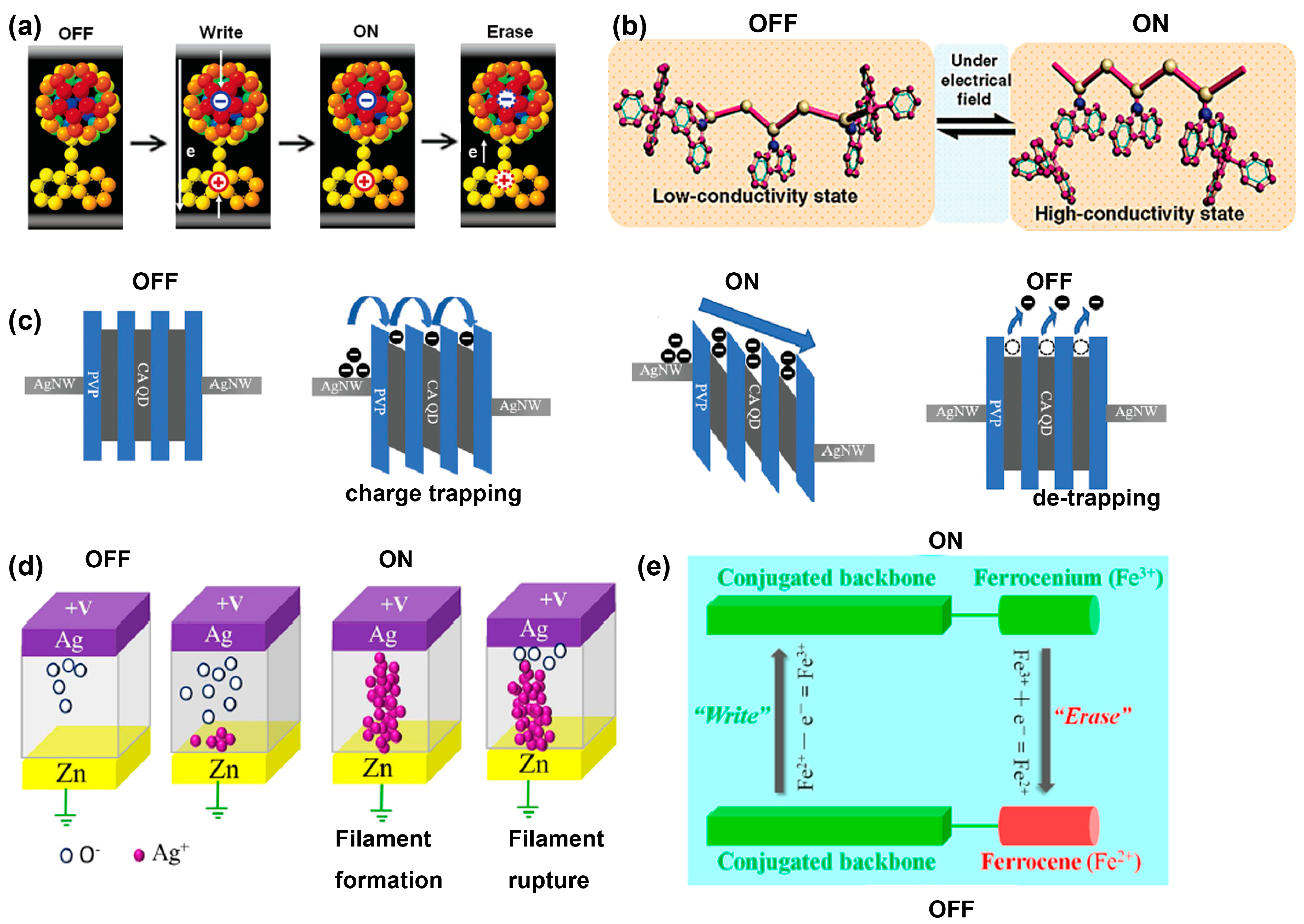

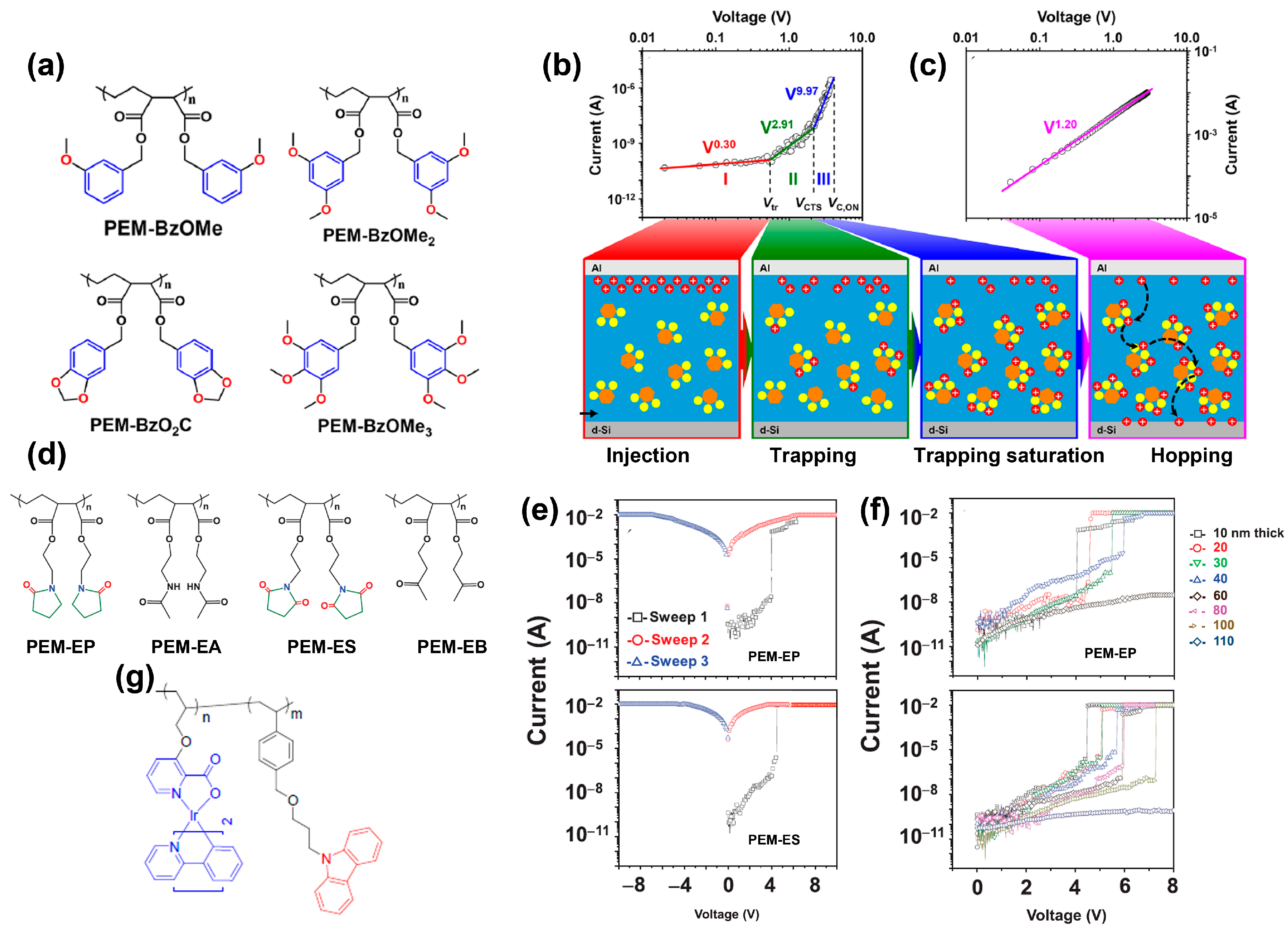
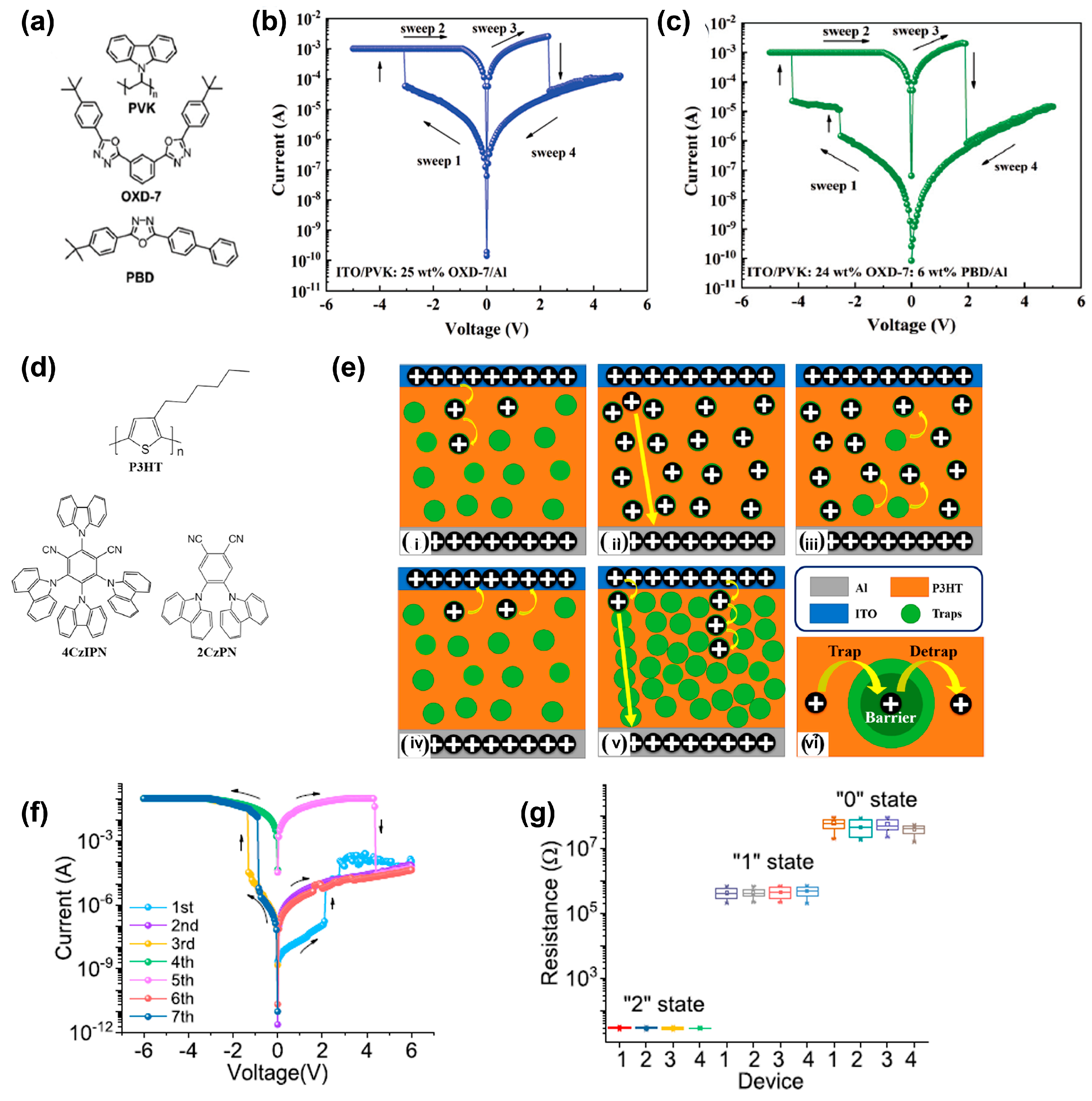
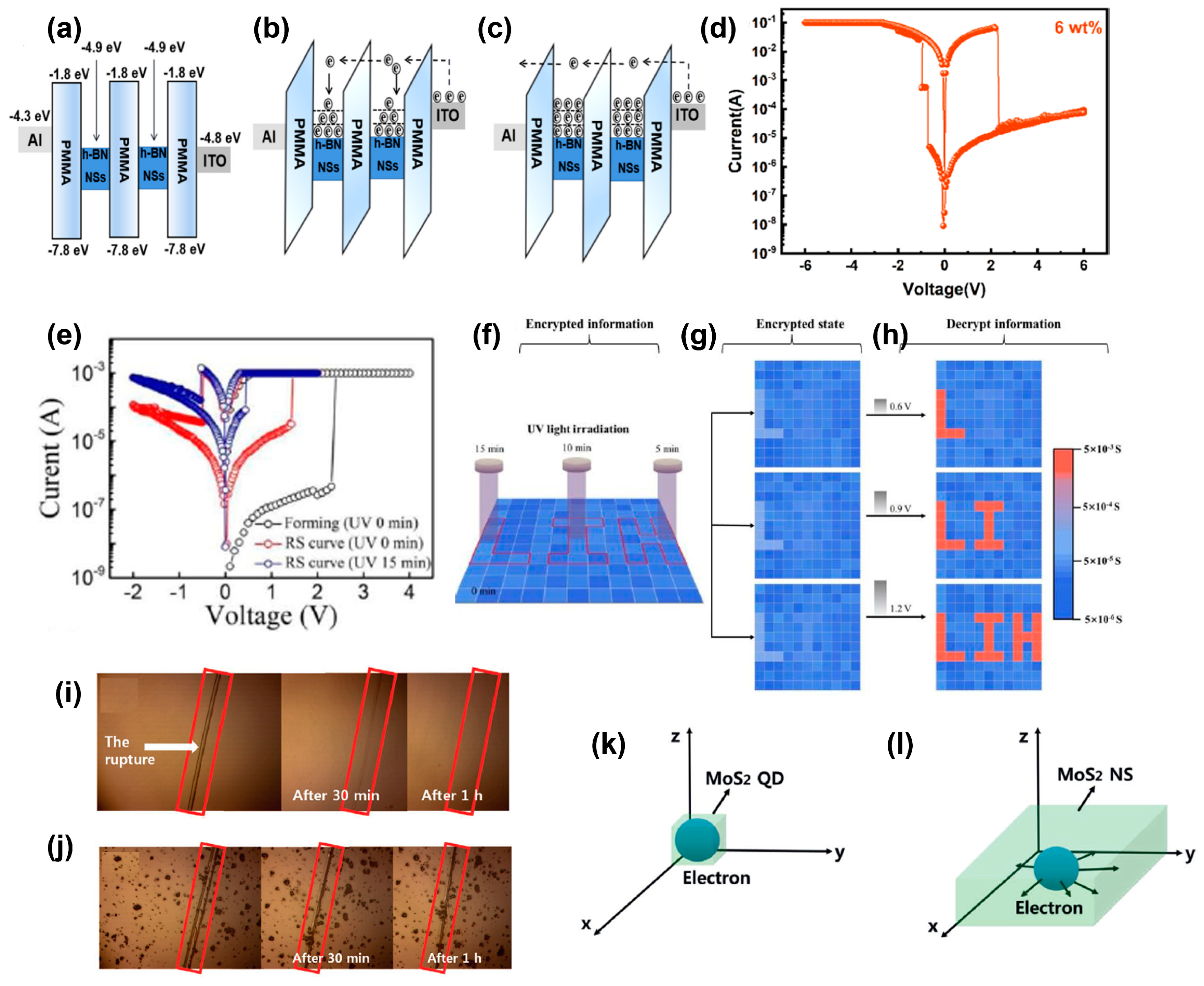
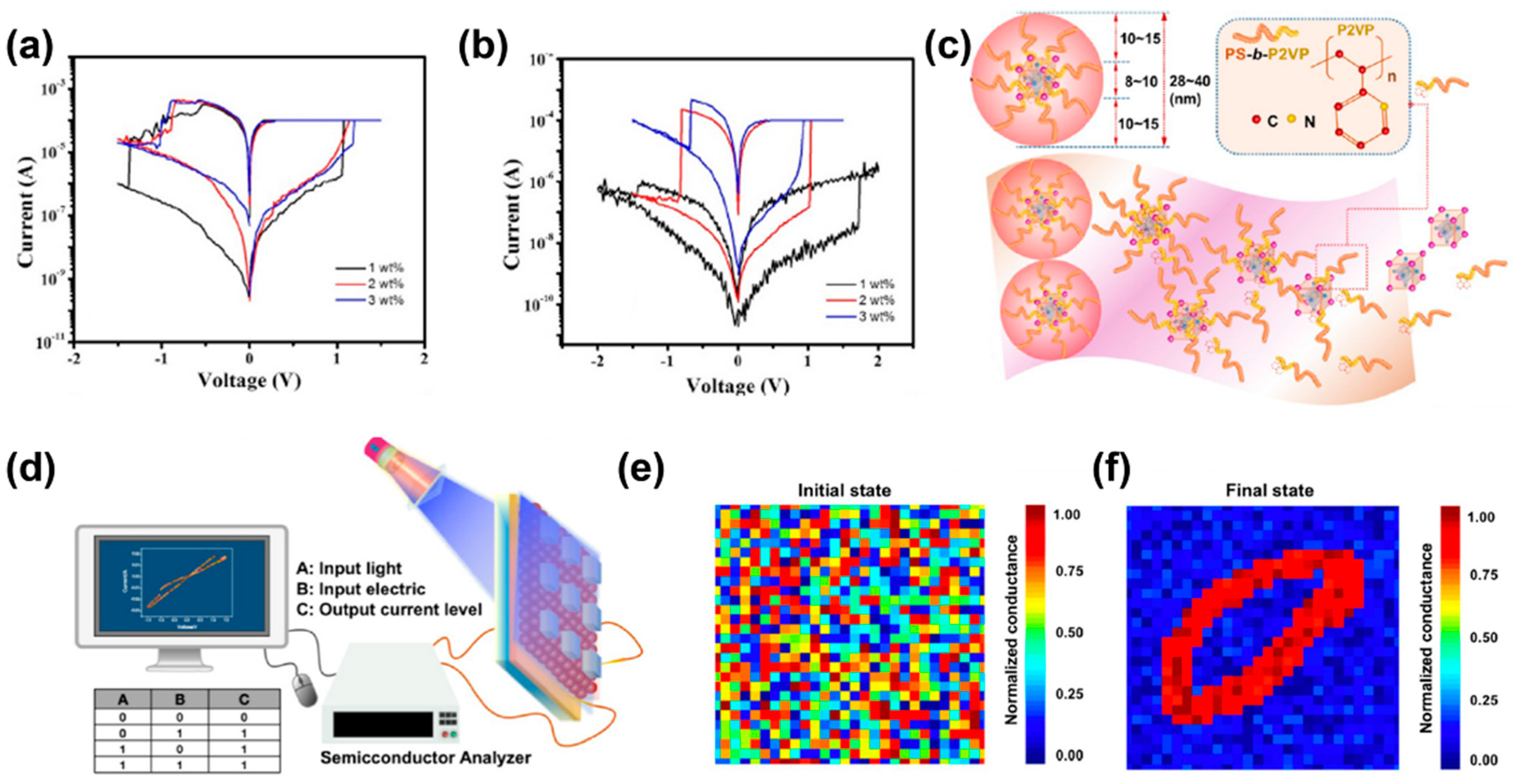

| Advantages | Disadvantages | |
|---|---|---|
| Single-component polymers |
|
|
| Polymer mixtures |
|
|
| 2D covalent polymers |
|
|
| Biomacromolecules |
|
|
Disclaimer/Publisher’s Note: The statements, opinions and data contained in all publications are solely those of the individual author(s) and contributor(s) and not of MDPI and/or the editor(s). MDPI and/or the editor(s) disclaim responsibility for any injury to people or property resulting from any ideas, methods, instructions or products referred to in the content. |
© 2023 by the authors. Licensee MDPI, Basel, Switzerland. This article is an open access article distributed under the terms and conditions of the Creative Commons Attribution (CC BY) license (https://creativecommons.org/licenses/by/4.0/).
Share and Cite
Li, B.; Zhang, S.; Xu, L.; Su, Q.; Du, B. Emerging Robust Polymer Materials for High-Performance Two-Terminal Resistive Switching Memory. Polymers 2023, 15, 4374. https://doi.org/10.3390/polym15224374
Li B, Zhang S, Xu L, Su Q, Du B. Emerging Robust Polymer Materials for High-Performance Two-Terminal Resistive Switching Memory. Polymers. 2023; 15(22):4374. https://doi.org/10.3390/polym15224374
Chicago/Turabian StyleLi, Bixin, Shiyang Zhang, Lan Xu, Qiong Su, and Bin Du. 2023. "Emerging Robust Polymer Materials for High-Performance Two-Terminal Resistive Switching Memory" Polymers 15, no. 22: 4374. https://doi.org/10.3390/polym15224374
APA StyleLi, B., Zhang, S., Xu, L., Su, Q., & Du, B. (2023). Emerging Robust Polymer Materials for High-Performance Two-Terminal Resistive Switching Memory. Polymers, 15(22), 4374. https://doi.org/10.3390/polym15224374






